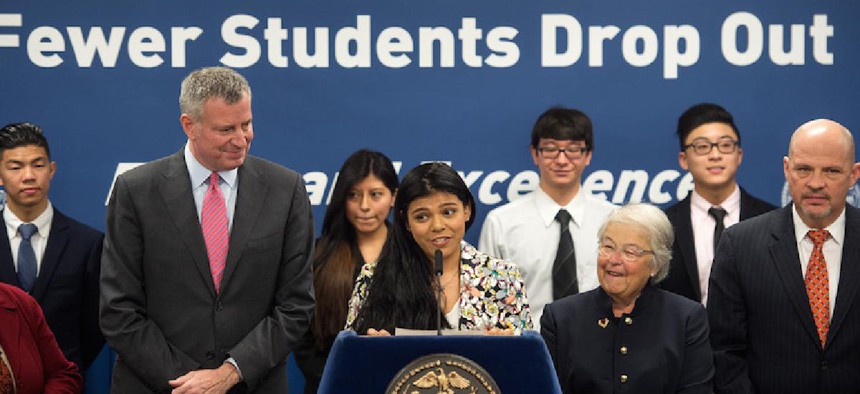In a bold attempt to break the link between neighborhood conditions and school quality for public school students, New York City launched a universal high school choice program in 2004. The idea was that opening up a wide range of high schools to everyone would give students from low-income neighborhoods access to better schools, and giving families the chance to “vote with their feet” would force low-performing schools to shape up or risk closure.
But in the intervening years, the city didn’t track student performance by home neighborhood, making it hard to tell how well universal choice is working, and for which students. To fill this gap, we gathered data on on-time graduation rates for high school students by their home addresses and mapped them onto the city’s 59 community districts.
We found that location is still highly associated with the likelihood of on-time graduation; meaning students from opportunity-scarce neighborhoods are lagging behind their wealthier peers – regardless of where they go to school.
Disparities in on-time high school graduation rates by neighborhood dwarf those by race, ethnicity and gender, with 34 percentage points separating the best- and worst-performing community districts.
More than 95 percent of students who live in Battery Park City, Greenwich Village and SoHo graduate within four years, compared with just 61 percent of students from Morris Heights, Fordham South and Mount Hope in the Bronx. The largest racial gap in high school graduation rate in the city, though still alarming, is much narrower: 85 percent of Asian students graduated on time last year, compared to 64 percent of Latino students—a difference of 21 percentage points.
Because the city didn’t track these data by place of residence in the past, we can’t assess how different access and outcomes are today than they were in 2004. Even if we had the data from the past, we would be hard-pressed to separate the effects of school choice from the effects of other educational reforms introduced around the same time, such as the shuttering of 29 extremely large, troubled schools.
However, we can use what we know now to begin to assess whether the collective investment in time, stress, and financial resources required of 80,000 eighth graders and their families each year by the high school choice process, not to mention the lengthier daily commutes for high school students, is worth it.
The early evidence suggests that it’s not – at least not for the young people from low-income, black and Latino neighborhoods who still wind up in schools with low graduation rates and classmates who share their socioeconomic disadvantages.
That’s because school access is just one of many factors determining opportunities and outcomes for kids. An analysis of the relationship between on-time high school graduation and other basic socioeconomic indicators using the free mapping and data analysis website DATA2GO.NYC proves that point. Neighborhoods with low on-time high school graduation rates were more likely to have high child poverty rates, low median household incomes and low shares of adults with bachelor’s degrees. Conversely, graduation rates tend to be very high in neighborhoods with low rates of Supplemental Nutrition Assistance Program use.
These findings point to a larger issue: it’s unrealistic to expect a school choice process carried out near the start of high school to remedy the effects of disadvantage, discrimination, and disinvestment years in the making. Making educational equality a reality requires investments in children, families and communities long before children reach ninth grade. The school choice program undoubtedly provides benefits to some children, but it assumes all kids have the resources and supportive adults in their lives needed to help them navigate a bewildering process. This is not the case.
Using these data on high school graduation rates by neighborhood as a baseline, the city should set a goal to slash the gap in graduation rates by community district and make the changes needed to get there. As a start, middle schools need more guidance counselors with smaller caseloads, and students need more good high school options to choose from.
Addressing larger issues of residential segregation by race and income, poverty, the absence of meaningful work, unsafe neighborhoods, lack of political power, and discrimination – challenges that high school students bring with them every morning they commute to high schools in different neighborhoods – is the fundamental educational reform that we as a society must ultimately be willing to make.
Kristen Lewis and Sarah Burd-Sharps are co-directors of Measure of America and co-authors of the study “High School Graduation in New York City” released on Wednesday.


